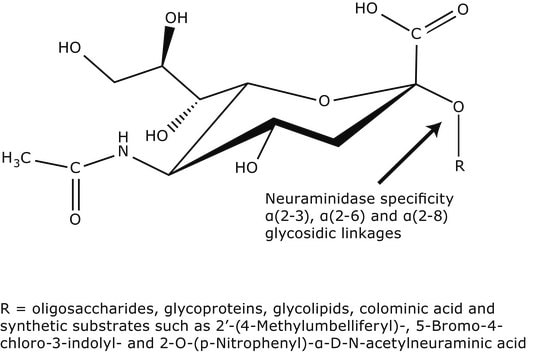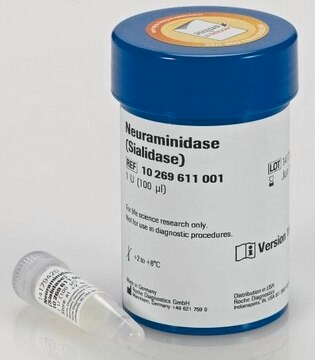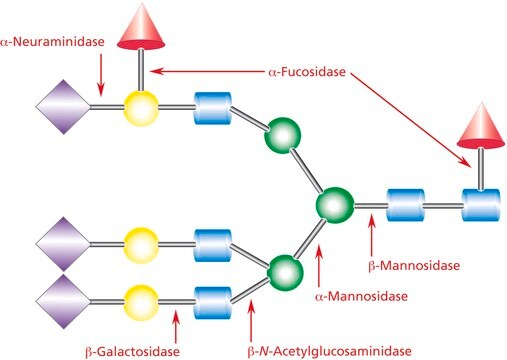N2133
Neuraminidase from Clostridium perfringens (C. welchii)
Type X, lyophilized powder, ≥50 units/mg protein (using 4MU-NANA)
Sinonimo/i:
Acyl-neuraminyl Hydrolase, Receptor-destroying enzyme, Sialidase
Autenticatiper visualizzare i prezzi riservati alla tua organizzazione & contrattuali
About This Item
Prodotti consigliati
Tipo
Type X
Livello qualitativo
Stato
lyophilized powder
Attività specifica
≥50 units/mg protein (using 4MU-NANA)
Temperatura di conservazione
−20°C
Informazioni sul gene
Clostridium perfringens str. 13 ... nanI(988807)
Cerchi prodotti simili? Visita Guida al confronto tra prodotti
Descrizione generale
Neuraminidase enzymes are glycoside hydrolase enzymes that catalyze hydrolysis of terminal sialic acid residues. The most well-known are the viral nearamidases, which promote influenza virus release.
Applicazioni
Neuraminidase from Clostridium perfringens has been used in a study to assess purification via affinity chromatography. It has also been used in a study to investigate site-directed mutations of amino acids of the neuraminidase gene, nanH.
Azioni biochim/fisiol
Neuraminidase can block attachment of type 3 reovirus to cell membranes. This effect is related to the ability of neuraminidase to hydrolysis sialic acid residues within cell surface receptors.
Neuraminidase cleavage of sialic acid groups has been used to study recognition by antibodies of glycoprotein structures. The use of neuraminidase in the estimation of N-acetylneuraminic acid was compared favorably to two other methods.
Neuraminidases are used to cleave terminal N-acetyl neuraminic acid (sialic acid) from a variety of glycoproteins. The enzyme from Clostridium perfringens cleaves terminal sialic acid residues which are α-2,3- α-2,6- or α-2,8-linked to Gal, GlcNac, GalNAc, AcNeu, GlcNeu, oligosaccharides, glycolipids or glycoproteins. The relative rate of cleavage decreases in the order: α-2-3 > α-2-6 . α-2-8. Neuraminidase from C. perfringens cleaves α-2-3 linked sialic acid residues most efficiently, compared to A. ureafaciens, (Sigma N3642) which preferentially cleaves α-2-6 linked residues.
The use of neuraminidase to remove sialic acid residues from glycoproteins on cell surfaces has been frequently reported. Generally, procedures have indicated using neuraminidase in PBS at 37°C for 30 minutes, followed by several washings with PBS. Treatment of tissue sections with neuraminidase at much lower concentrations require longer incubation: for 1-4 U/mL in 0.1 M acetate buffer pH 4.2-5, from 2 to 20 hours at 37 °C.
Definizione di unità
One unit will hydrolyze 1.0 micromole of 2′-(4-Methylumbelliferyl)-alpha-D-N-actetylneuraminic acid per min at pH 5.0 at 37 °C.
Nota sulla preparazione
Purified by affinity chromatography from Type VIII (N 5631)
Risultati analitici
Package sizes based on 4MU-NANA units
Package sizes based on the 4MU-NANA units
Avvertenze
Danger
Indicazioni di pericolo
Consigli di prudenza
Classi di pericolo
Resp. Sens. 1
Codice della classe di stoccaggio
11 - Combustible Solids
Classe di pericolosità dell'acqua (WGK)
WGK 1
Punto d’infiammabilità (°F)
Not applicable
Punto d’infiammabilità (°C)
Not applicable
Dispositivi di protezione individuale
Eyeshields, Gloves, type N95 (US)
Scegli una delle versioni più recenti:
Possiedi già questo prodotto?
I documenti relativi ai prodotti acquistati recentemente sono disponibili nell’Archivio dei documenti.
I clienti hanno visto anche
Purification of neuraminidases from Vibrio Cholerae, Clostridium Perfringens and influenza virus by affinity chromatography.
P Cuatrecasas et al.
Biochemical and biophysical research communications, 44(1), 178-184 (1971-07-02)
J Shemer et al.
Diabetologia, 29(5), 321-329 (1986-05-01)
Specific insulin receptors are present in the liver and brain of the lizard Anolis carolinesis. In this study, the specific binding of 125I-insulin to the receptors showed time, temperature and pH dependency. Specific binding to crude membranes prepared from brain
L V Gubareva et al.
Lancet (London, England), 355(9206), 827-835 (2000-03-11)
Neuraminidase promotes influenza virus release from infected cells and facilitates virus spread within the respiratory tract. Several potent and specific inhibitors of this enzyme have been developed, and two (zanamivir and oseltamivir) have been approved for human use. Unlike amantadine
C H Chien et al.
Enzyme and microbial technology, 19(4), 267-276 (1996-09-01)
The small nanH gene encoding the neuraminidase from Clostridium perfringens ATCC 10543 was cloned in JM109 using pUC19 as a vector. Sequence analysis revealed an ORF encoding 382 amino acids without a signal peptide sequence. Four regions of amino-acid sequence
Marjorie E Kanof
Current protocols in immunology, Chapter 7, 7-7 (2008-04-25)
This unit describes a procedure for separating T cells from other mononuclear cells by exploiting the unique ability of cells to bind to and form rosettes with sheep red blood cells (SRBC). This isolation method also allows recovery of the
Protocolli
Il team dei nostri ricercatori vanta grande esperienza in tutte le aree della ricerca quali Life Science, scienza dei materiali, sintesi chimica, cromatografia, discipline analitiche, ecc..
Contatta l'Assistenza Tecnica.











